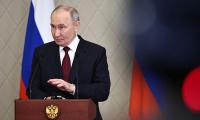LAHORE: Pakistan took too long to suspend trade with India that was a non-starter after 1965 war. The suspension did not have much impact on the economies of both countries, as value traded was nominal compared with total trade of each country.
After Pulwama, the Indians made it impossible for Pakistani goods to land in India. First the so called Most Favoured Nation status of Pakistan was withdrawn and then punitive duties were imposed on all major export items from Pakistan. The government of Pakistan however showed restraint and placed no curbs on imports from India.
Trade between both nations stood at just $2.4 billion in 2017-18, accounting for a mere 0.31 percent of India’s total trade with the world, and just about 3.2 percent of Pakistan’s global trade. Around 80 percent of the traded goods came from India and only 20 percent exported from Pakistan.
Pakistan in 2017-18 exported cement ($78.3 million), fertilisers ($34.9 million), fruits ($112.8 million per year), chemicals ($60.4 million) and leather and allied products to India. The trade volume further declined in 2018-19 mostly impacting Pakistani exports because of Indian punitive measures.
The main items India imports are fresh fruits, cement, petroleum products, bulk minerals and ores and finished leather. The major Indian exports to Pakistan include raw cotton, cotton yarn, chemicals, plastics, manmade yarn and dyes.
Indian economic planners think much ahead of planners in Pakistan. The rapid and constant decline in Pakistani rupee was making many Pakistani products cheaper for Indian market. The Indians imposed restrictions before these products actually penetrated into their markets. The Indians also realised that after completion of CPEC they would lose the advantage of proximity of borders that reduced transport cost of goods appreciably.
We all know that China is the cheapest supplier of goods and services to the entire world. Pakistani market before CPEC was 16,000km away from the nearest Chinese port. Even then many Chinese products and chemicals competed with the Indians. After CPEC the trade route has been reduced to 2,700km up to Karachi.
For KP and Punjab the distance is half. Indians would have otherwise lost most of Pakistani market to Chinese when CPEC became fully operative. The Indians thus knew that they are going to lose most of the Pakistani market to Chinese in two to three years.
They also knew that weak Pakistani rupee would increase Pakistani exports to India substantially so they first curbed imports and kept exporting goods to Pakistan till they lose out to Chinese.
The CPEC is a very important route and once it is fully operative, the Indians would badly need it to remain competitive in Chinese and Central Asian economies. The Indians would offer Pakistan to restart trade. Pakistani planners would have to show patience and negotiate favourable terms of trade – a trade without any implicit or explicit trade barrier. Otherwise this trade route should be denied to India.
The potential for bilateral trade between India and Pakistan is above $37 billion according to a recent study by the World Bank. We never achieved even 10 percent of this potential. India never addressed Pakistan’s concerns with regard to tariff and NTBs, especially in the textile and agriculture sectors. This is the reason that a large section of Pakistani businesses were apprehensive about opening up their markets to India.
The history of trade between Pakistan and India speaks volumes about the distrust that each has against the other. In the first 18 years after independence (1947-1965), particularly in the beginning of this period, the two countries and their economies were reasonably integrated, buoyed by an India and Pakistan standstill agreement under which goods from one country to another were exempted from customs duty.
In addition, there were few visa restrictions. The closeness of ties is reflected by the fact that, in the immediate aftermath of independence, the volume of trade was quite high. The high volume of trade is mirrored in high shares in total import and export of the two countries. During 1948-49 period 23.60 percent of Indian exports were to Pakistan while 50.60 percent of its imports came from Pakistan.
This trend depicted the integration of regional economy. The 1965 war put a stop to this trade and when it was resumed a decade later, Indian exports accounted for only to 1.3 percent of its total exports and 0.6 percent of total Indian imports in 1975-76.
An outer view of a branch of Bank Makramah Limited. — yandex maps/FileKARACHI: The Bank Makramah Limited’s board...
A Meezan Bank seen in this undated image. — Agencies/FileKARACHI: Meezan Bank Limited has partnered with Systems...
A representational image of gold jewellery. — AFP/FileKARACHI: Gold prices decreased by Rs700 per tola on Thursday...
A representative image for tax. — Reuters/FileLAHORE: The inability to establish a credible fear of audits is a...
British Prime Minister Keir Starmer attends a bilateral meeting with President Xi Jinping of China, at the Sheraton...
Sindh Energy Minister Syed Nasir Hussain Shah gestures during a meeting on March 19, 2024. —...







